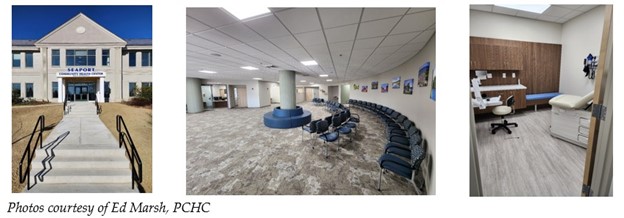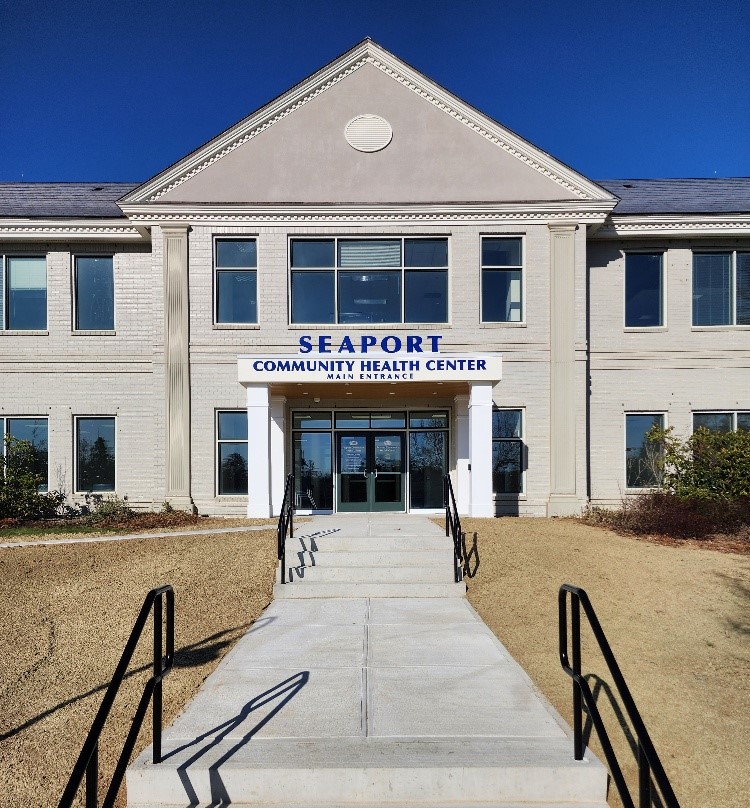The Right Equation for Responsible Development: Spotlight on Seaport Community Health Center (Belfast)
MEREDA Recognizes its 2024 Notable Project Award Recipients –
Each year, the Maine Real Estate & Development Association (MEREDA) recognizes some of the state’s most “noteworthy and significant” real estate projects, completed in the previous year. The exemplary projects from across the state, completed in 2024, not only embody MEREDA’s belief in responsible real estate development, but also exemplify best practices in the industry, contributing to Maine’s economic growth by significant investment of resources and job creation statewide.
This year, MEREDA honored projects from throughout the state, with each receiving special recognition at MEREDA’s 2025 “Notable Night” social celebration in May.
In a multi-part series exclusive to the Maine Real Estate Insider, we’ll provide an up-close look at the most notable commercial development projects of the past year that are helping to fuel Maine’s economy in terms of investment and job creation. MEREDA is proud to recognize responsible development based upon criteria including environmental sustainability, economic impact, energy efficiency, difficulty of the development, uniqueness, social impact and job creation.
Mainebiz also featured each of our Notable Project Recipients in their inaugural “Groundbreaking Maine” publication. Be sure to check it out! https://www.mainebiz.biz/special-edition/groundbreaking-maine-2025
MEREDA’s 2024 Top 9 recipients include:
Firehouse Village, Firehouse Ventures & Avesta Housing (Scarborough)
99 Western Apartments, Mastway Development (Augusta)
The Malone Family Tower, MaineHealth and Perkins&Will (Portland)
Seaport Community Health Center, Penobscot Community Health Care (Belfast)
Katahdin Woods and Waters National Monument: Tekαkαpimək Contact Station, Elliotsville Foundation (T3 R7 WELS)
Vertical Harvest, Vertical Harvest Maine (Westbrook)
Stacy M. Symbol Apartments, Westbrook Development Corporation (Westbrook)
Nightingale & State Street Campus Redevelopment, NewHeight Group & Redfern Properties (Portland)
Front Street Redevelopment, Portland Housing Authority (Portland)
Please join us this week in celebrating Seaport Community Health Center.

MEREDA: Describe the building and project.
Penobscot Community Health Care: Penobscot Community Health Care’s (PCHC) new Seaport Community Health Center arose from a dire need to expand that began in 2017 with no capacity to accept new patients, no space for dental care, and a new landlord not interested in a long-term lease. With a vision, they set out on a nine-month search to find a suitable new location and kept coming back to the nearby, mostly vacant five-building, 318,979 square foot, 142-acre former MBNA Bank of America complex in Belfast, Maine.
Following PCHC’s purchase of the entire campus, $9.6 million in financing by Evernorth Rural Ventures’ New Markets Tax Credit (NMTC) program, the Primary Care Development Corporation (PCDC), the Health Resources and Services Administration (HRSA), PCHC, and CapitalOne, N.A., acquired and renovated one of the buildings, creating:
• 1st floor exam, behavioral health, and consultation rooms; large patient lobby and reception area; staff offices, conference room, breakroom, and kitchen totaling 35,295 square feet; and
• 2nd floor 35,295 square feet gray box space for the fit out and equipping of a future dental practice and other related services.
MEREDA: What was the impetus for this project?
Penobscot Community Health Care: Prior to the project the health center operated in 11,727 square feet of leased space 0.3 miles away. The new facility enables an expanded Seaport Community Health Center to attract new providers and serve more patients, and respond to a growing rural, medically underserved population.
PCHC is a 501(c)3 nonprofit federally qualified health center (FQHC). It is the largest FQHC in Maine and second largest in New England. A FQHC is a federally funded nonprofit health center or clinic that serves medically underserved areas and populations. Primary care services, fully integrated with behavioral health care, are provided on a sliding scale fee based on a patient’s annual income and family size.
MEREDA: That sounds like quite a process. How long were you in the planning stages before construction started?
Penobscot Community Health Care: PCHC purchased the complex in December 2021 – it was never their intent to be real estate developers but this was the best solution for their expansion needs. From the outset, PCHC was and remains fortunate to have Bank of America as the anchor tenant and a stable partner.
To complete the project, PCHC needed to raise or borrow approximately $2.8 million in additional capital to fill a gap following capital secured from the Primary Care Development Corporation (PCDC), the Health Resources and Services Administration (HRSA), and PCHC’s own capital. At market rates in 2023 financing would cost $4.5 million of additional cost, rendering the project economically unviable. The patient, flexible, below market NMTC financing from Evernorth reduced the debt load freeing up funds to accomplish the expansion project.
MEREDA: Tell us about the most challenging aspect of getting this project completed.
Penobscot Community Health Care: Challenges that arose during the two years from purchasing the property to opening the doors to patients included increased costs, staff shortages, labor shortages, a global pandemic, delays resulting from the financing structure creating a gap in the development budget, redrafting of documents and discovering that the 316,579 square foot ‘white elephant’ facility – built by MBNA all as one building and connected and not ‘cut up’ so PCHC had to navigate the legal, permitting, and design process to create condos – stand-alone structures, disconnecting the building for it to be redeveloped.
MEREDA: Something unexpected you learned along the way was….
Penobscot Community Health Care: Some unexpected situations that arose included miles and miles of data cables throughout the buildings that could not be used; trying to repurpose hundreds of left behind cubicles and chairs, mechanical systems that had sat dormant for years including 35 existing commercial heat pump units that all needed maintenance.
Words of advice from the folks at PCHC: When taking on an endeavor of this size, really do the due diligence and surround yourself with people who are experienced vs learning along with you.
MEREDA: Now that it’s complete, what feature of the project do you think makes it the most notable?
Penobscot Community Health Care: Now that the new health center is open and thriving, some notable outcomes include: The accessible waiting room is the most notable, spacious, clean and professional, the private patient check in service areas built within the common areas, the full service pharmacy – and the well apportioned exam rooms and private space for employees.
Externally, PCHC has opened the enclosed atrium space for community use, hosting the weekly Belfast Winter Farmers’ Market.
Most notable is how PCHC’s vision, investment, and blazing the path ahead has invigorated local developers to reimagine the remaining vacant spaces in the complex. PCHC’s investment brought life back into the campus, laying the foundation for redevelopment of the remaining buildings and parcels, stimulating future private investment within the designated low-income community for other important community services such as childcare and affordable housing. All bringing more awareness to the Seaport Community Health and its critical service to the community.

